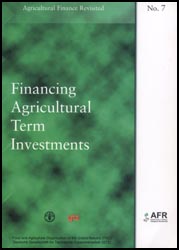
Agricultural Finance Revisited No. 7
AGRICULTURAL FINANCE REVISITED
FINANCING AGRICULTURAL TERM INVESTMENTS
FRANK HOLLINGER
January 2004
Food and Agriculture Organization of the United Nations (FAO)
Deutsche Gesellschaft für Technische Zusammenarbeit (GTZ)
NO. 7